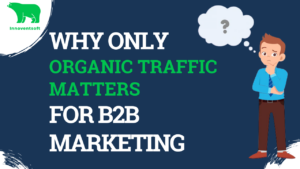Why blogs are essential to increase organic traffic
A blog is a website that is constantly updated or a webpage, usually created by an individual or small organization, written in an unusual or conversational way.
A blog can be written by anyone to convey an idea, thought, or idea. Blogs are usually written by an individual or a small group of people to provide records in a conversational manner. However, there are now tonnes of corporate blogs that produce a wealth of informational and mind-management content.
There are various reasons for writing a blog, some of which are:
- Manage your identity, expand your social network, and build trust.
- Improve your writing skills and learn new things.
- Declared as a subject expert
- You could become a writer or be invited to speak.
- You can sell products or services for your business.
Blogs have become an important channel for marketing business products and services. You can write about the product, share feedback, tell people how to use the product, and much more. Properly written blogs with the right strategies can increase organic traffic on your business website, get you a better track record, and ultimately increase your revenue.
Let’s discuss how we can use blogs to increase organic traffic to your website.
Steps to create good blogs and increase organic traffic
There are 6 steps using which one can produce optimized blogs for the target audience. The below image represents all the 6 steps which will help a digital marketer and a product marketer to work jointly and make sure the content is optimized.

1. Produce fresh, high-quality content
Today, hundreds, if not thousands, of ideas are rewritten online. The problem is not the idea but the implementation. It’s okay to write content about how to use a knife, but it may look like a competing blog post. Search engines prioritize new, high-quality content. Create blog ideas and write something new. If the topic is new, combine new ideas with old ones to improve its quality.
2. Understand your target audience for organic channels
Knowing your target audience/market is the key to creating content that sticks. The first step is to set up your online persona. The buyer persona represents your best buyer and will build and value your way as you go deeper into the process. By studying the market and gathering information from current customers, you can create a customer-friendly mix in the market. In fact, you target your target audience and understand their needs, and you want to attract them better—like honey bees.
Keep in mind that your target audience may change and may change over time. Make sure you occasionally consider your target audience in order to provide your content to them.
3. Find keywords or customer intension in organic channel
Long-tail keywords have a better chance of measuring and can draw higher traffic than simultaneous keywords.
Many seasoned Google users have discovered that they cannot reach their destination by using common words. Instead, people tend to search for keyword phrases such as “how to use a knife.” When comparing “knife” and “using a knife” using a key research tool, we find that the first one is much harder to place than the last.
Simply, this means that there is a better chance of measuring the keyword “how to use a knife.” Note that the keyword you selected may not have the maximum search volume, but if you cannot measure a keyword with a longer or longer tail associated with the word “knife,” you will end up with a higher traffic value.
4. Place your post right next to your keyword
Once you have a targeted keyword, you need to upgrade your post to it. Your keyword should appear in the following:
Title tag for SEO
When content is displayed on search engine results pages (SERPs), SEO title tags are often the first thing to catch your eye. The title tag is shown as the name of the web page, and you can click on the link. The length is unlimited. However, Google shows up only 70 characters in the SERP. If your SEO title tag is longer than 70 characters, you need to rearrange the words to enter the keyword first.
URL
The URL is not the most important part of a keyword, but it is one of the first places a keyword comes from. Another Google guide and visitors to your blog on the subject of your content. The URL appears not only at the top of the web page in the address bar but also at the bottom of the SERP SEO title tag.
Meta description
The selected keyword is displayed in the meta description. The meta description of the SERP also contains text in the URL. Combine the use of keywords to attract readers with the definitions you have to click on.
Title
The title of the page after the reader has clicked on your content is the title of the article. Try to use keywords as naturally as possible here. If you are still unable to come up with an annoying variation, leave the keywords as they are and replace them with another title.
Subtitles
Before a reader works on all the content of a web page, he or she examines it. Subtitles make it quick and easy to digest information. Enter keywords in the headings to help visitors determine how important your content is to them.
Pictures and other articles
Do not underestimate the value of using keywords to enhance your images. Images are one way people can find your content. When saving an image to a blog post, use keywords in the title. The second area is related to the image using the keyword alt text. Some text is used to describe the image and make the content accessible to people with disabilities. Yes, you need to use keywords in the alt text, but it should be clear enough in case you can’t see the image.
Physical content
Keyword congestion is the number of times a keyword appears in your content and is usually expressed as a percentage. There is no target for this. Instead, create your content with your readers and keywords in mind. Then double-check your content to see if you can add keywords naturally without abusing them. To get started, try entering keywords every 100,200 words.
5. Improve your content quality and credibility with links
Proper use of links can increase the reliability of SERPs as content and resources. Pay attention to interlinks and backlinks when creating content.
Interlinks
Think of creating content as drawing a map. They guide your readers on where to go next. Direct them with interlinks. A link is a link to another related article on your site. The main advantage of this is that the visitor stays on your website for a long time. It also improves the quality of content by providing readers with additional resources to complete their knowledge.
Pay attention to the text of the anchor link when setting the interlink. Using the same text for certain inbound links on your website can adversely affect your SEO. Change the way you use words and phrases while linking to the same web page.
Backlinks
Backlinks increase reliability. Backlinks are links from one website to another, and the more backlinks you have, the more credible your website is to other websites and search engines. If your content links to another website, that organisation has a backlink from you. When another website links to your content, you have backlinks from them.
How do you prepare your website for backlinks? Create linkable content. You always need to link to quality content, such as blog posts, infographics, videos, and polls.
6. Publish regularly in organic channel
Finally, publish your post. Depending on how often Google and other search engines scan your site, it may take several days or more for your page to be indexed and appear in Google Search. A simple tip for ranking pages faster in search engines is to publish them more often. When Google detects that your website is updated daily, it scans your website more regularly.
Parting thoughts
Implementing all the above techniques to draw organic traffic through your blog might look complex. However, with Innoventsoft, you can increase organic traffic, leads, and revenue easily. ICM is an AI-based content marketing platform to help brands create valuable content quickly for Google search. With ICM, any organization can increase brand awareness, grow website traffic, and generate leads from the website.





